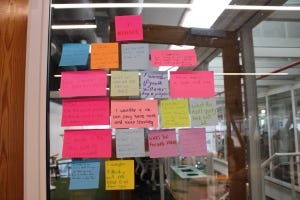Thoughts on journalism innovation + What I’ve been reading
A bit of a different piece for this week (a couple of interesting links are below this) as I’ve been fortunate to be involved in this year’s journalism leadership and innovation programme at the University of Central Lancashire.
My involvement has been in supporting this year’s cohort on their journalism innovation projects, from everything about pitching, to financial rigour around business casing, to strategic thinking and everything in-between.
It’s been an absolute pleasure to have a ringside seat on all the different ways this diverse group of participants are approaching the way they are re-thinking their approaches to journalism in different time zones, sectors and beyond.
From working with them, in no particular order, are some takeaways on threads or themes which flow through innovating within journalism and media but could happily, I think, be applied to many different sectors.
Consistency is key. Everyone has ideas, actually doing them is another thing. The key in doing something new and different is to try and make it manageable. How can you start out with a slight tweak or something that isn’t too time intensive but allows you to test and learn? A lot of people think innovation is throwing ‘spaghetti at the wall’ and seeing what sticks. And that is one approach but I think, especially within busy newsrooms and those with audiences to serve and deliver for, then carving out one post a day in a social schedule to try that new format or within a weekend audience plan assigning one story to be a different type of format is a great place to start. And then be consistent and give it time to see if it’s working, or not.
Now, next, later. There’s a lot of innovation in the journalism space, AI, memberships, subscriptions, new young audiences, WhatsApp channels, and plenty more. Your head can quickly spin when you think about what you should be doing and where to take your news organisation. This technique, taught to me by the very clever Laurens, means you are recognising the potential to do other things but you’re making it very clear on what you, and your team, are doing to focus on in the coming days and weeks – while keeping sight of the bigger picture. So for example, you may say….
Now: We are going to bring in a freelance reporter one-day-a-week to do three extra stories about climate change each week which will be included in our newsletter, social channels and homepage
Next: We will then look at seconding one of our more experience reporters into a climate change beat and setting up a social account all about our climate reporting
Later: Launching a dedicated new brand about climate with new social channels, a section of the site, a newsletter and seeking commercial partners to support and grow a dedicated team covering climate issues
Your why. It’s always interesting to see what people pick as their innovation project within the cohort – and it varies wildly. What’s important is you’re able to articulate why you’ve chosen it, people back people. So while you have some great figures, or product idea, if you can’t articulate the ‘why’ behind the idea you’ve come up with – and show something of yourself within it, then it is often harder to get traction. Are you picking something because you really believe in it for the future of journalism, or are you just trying to impress the suits?
Talk to people. Be this the people who you think will be interested in consuming or using your idea, product, service, content and get their views. What makes them tick? What makes them angry? What makes them happy? There’s a fantastic piece from Jacqui Merrington about user-led design and research taken from the sprint process the group followed. But also talk to your colleagues, both within your own team but also outside of it. Support for ideas can sometimes come from unlikely places. And also talk to your friends, your family, acquaintances, people who think might be interested. The more you articulate your idea, out loud beyond a scribble in a notepad, the more real and defined it will come.
Resources and purpose. Most ideas take money, and time and to have time, you tend to need money. Not everyone needs to be a chief finance officer or a spreadsheet genius, but it’s important to at least know the basics. How many times in Dragons Den is it all going well up until the numbers bit? And linked to your why, money is needed to fund actions and infinitives to have a very clear, well-defined argument, for why the money or resource is needed to achieve the outcome.
Where it starts will not be where it ends. Best laid plans and all that, as with life – there will be many twists and turns on turning your innovation project into a reality. Be prepared to adapt (sometimes adapting is needed to survive) and don’t be disheartened if your idea has to pause or re-shape because of external factors. Get comfortable with the plan needing to bend and flex as circumstances change – and within the journalism and media environment – this is crucial because external forces will always be at play both positive and negative.
If it’s new to you, it’s innovative. A lot of people seem to think that they must try and have a eureka type moment, where they step foot on the Moon and are the first into a new space. The reality is, lots of people will likely be there before you. But, that doesn’t mean your idea isn’t innovative. If it’s new to you, your organisation and your context then it’s still an innovation. And imitation is a completely acceptable form of innovation, however, it’s crucial to ensure it’s done within the context of your organisation/circumstances – and there’s a ‘why’ as to why you think it’s the right route for you.
The cohort are now in the final stages of putting their innovation project to paper, so good luck with it and may your coffee be strong in hitting the deadline!
And now, a piece that has caught my eye in the past week to feature…
It’s content – get over it – Alan Hunter – a really strong and important piece of writing from Alan about how journalism needs to see itself as a part of a digital content mix and I’d add understand that as media organisations you’re in a fight for attention (and have always been!). No matter the platform, or distribution method, there has always been competition for eyeballs and time – so I think it comes back to being useful. If you’re useful, then there’s a reason for people to seek you out and come back. And therefore useful content will win out.
And a plug for something I was involved in, if I may, on Friday I was part of the team that organised the Big PNE Sleep Out. I was back on the reporting front line, doing a Facebook Live, getting quotes, doing social posts and committing an act of local journalism.
Most importantly the total raised is approaching the £40,000 mark with gift aid and other donations rolled in. An incredible effort from everyone who bedded down for a very soggy night at Deepdale. You can still donate here.
A reminder you can get this round-up in your inbox first by subscribing to my newsletter on TinyLetter, it comes out each Wednesday afternoon.





